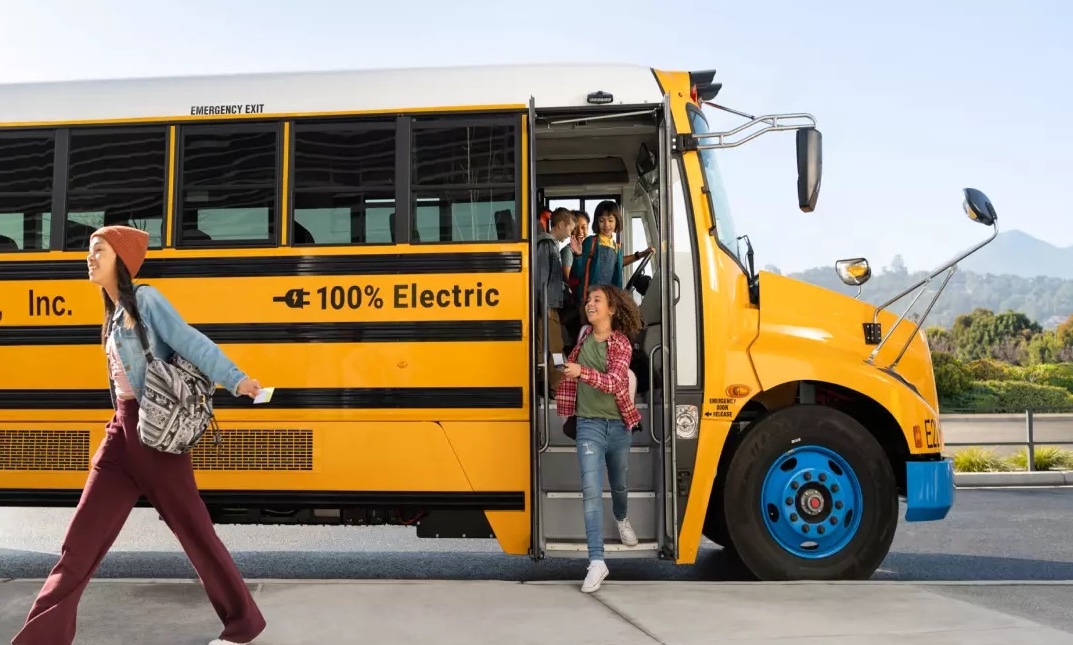
by Francisco Sayu | Apr 27, 2023 | Electric Vehicles, Electrification, Inflation Reduction Act
The Environmental Protection Agency (EPA) just announced a new round of competitive funding through the Clean School Bus (CSB) Grants Program. This is the second funding opportunity for clean school buses from the Infrastructure Investment and Jobs Act (IIJA). Unlike the 2022 Clean School Bus Rebates, this new funding opportunity is competitive – instead of a lottery. We encourage school districts to partner with other communities, transportation providers, and electric utilities for their application. Any eligible school district or third-party applicant must be set up on grants.gov and SAM.gov. Interested parties should confirm they are registered and current on both websites as soon as possible.
Why Electric School Buses?
Cost savings: electric buses get the equivalent of 17 miles per gallon (MPG) compared to 6 MPG for diesel buses; these savings can amount to more than $170,000 across the bus lifecycle.
Health benefits: electric school buses cut diesel emissions, benefiting communities burdened by air pollution and high childhood asthma rates.
Energy security and independence: electric buses can run on locally sourced renewable energy from a nearby solar or wind farm, which helps the local economy.
Electric buses have operated safely and reliably in many parts of the United States, including Michigan, Minnesota, and Alaska. Although electric buses are cheaper to own and operate than traditional diesel buses, the initial cost of new buses has been a barrier to adoption, and only a few schools have been able to afford them. The Clean School Bus (CSB) Grants Program is solving this problem by covering up to 100% of the cost of new buses so that schools can save money without a significant out-of-pocket expense. Sounds too good to be true? Check out this blog post to find the list of school districts that already received awards for new electric buses in Wisconsin.
2023 Clean School Bus (CSB) Grants Program Overview
The EPA is awarding approximately $400 million in competitive grants under the Clean School Bus (CSB) Grants Program. The grant application will allow for a minimum of 15 buses and up to 50 buses for school district applicants and for a minimum of 50 and up to 100 buses for third-party applicants serving at least four school districts. Awardees will receive up to $395,000 per bus without cost-sharing or matching requirements. Applications must be submitted electronically to EPA through grants.gov by Tuesday, August 22, 2023, at 11:59 p.m. (ET).
Eligible applicants include the following entities:
- Local or State governmental entities providing school bus service to one or more public school systems
- Indian Tribes, Tribal organizations, and tribally controlled schools providing school bus service to one or more Bureau-funded schools
- Nonprofit school transportation associations
- Public charter school districts responsible for the purchase, lease, license, or contract for the service of school buses for that charter school
- Eligible contractors
Please refer to the grant Notice of Funding Opportunity (NOFO) for specific information about this
competition.
Important Dates
| Activity |
Date |
| Information Sessions |
The first Information Session will be on Wednesday, May 10, 2023, at 3:00 p.m. (ET). Click here to register. |
| Deadline for Submitting Questions |
Wednesday, August 9, 2023, at 11:59 p.m. (ET) |
| NOFO Closes – Application Deadline |
Tuesday, August 22, 2023, at 11:59 p.m. (ET) |
| Anticipated Notification of Selection |
November 2023 to January 2024 |
| Anticipated Awards |
February to March 2024 |
Schools can submit questions to cleanschoolbus@epa.gov. Please type “Clean School Bus NOFO Question” in the subject line of your email. The deadline for submitting questions via email is Wednesday, August 9, 2023, at 11:59 p.m. (ET). Schools may also contact Francisco Sayu, Emerging Technologies Director RENEW Wisconsin, at francisco@renewwisconsin.org, for general help with this grant application.
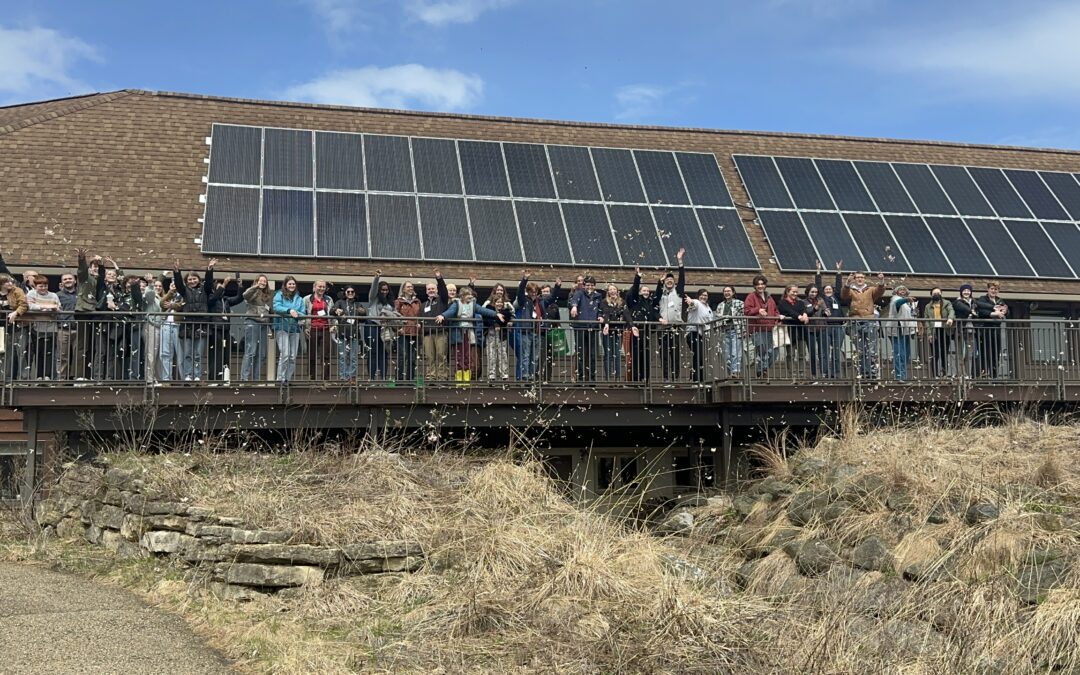
by Lauren Cohen | Apr 26, 2023 | Solar, Solar for Good
On Saturday, April 22, The University of Wisconsin Madison Arboretum celebrated Earth Day by holding an event dedicated to celebrating their sustainability efforts, including a solar dedication ceremony. They aim to conserve and restore the Arboretum lands, advance restoration ecology, and foster the land ethic.
SunPeak installed this 25.16 kW solar system on the Arboretum Visitor Center, and consists of 66 PV modules. The system is estimated to produce 32,000kWh of annual energy and will cover around 8% of the Arboretum’s electricity needs.
The University of Wisconsin Madison Arboretum includes the world’s oldest and most varied collection of restored ecological communities. With this global status, it is expected that the visibility of this solar array will be far-reaching. “Our mission to foster the land ethic involves promoting sustainable relationships between people and the land,” said Karen Oberhauser, Director of the Arboretum. “A key driver of people/land interactions involves energy production, extraction, and consumption. Thus, we are dedicated to decreasing our institutional carbon footprint, serving as an example of sustainable energy production and use.”
This project received funding from Focus on Energy and a generous donation from Friends of the Arboretum, and the Green Fund, a program of the UW-Madison Office of Sustainability that supports student ideas to improve campus stability. In addition to this financial support, The University of Wisconsin Madison Arboretum also received a panel grant from Solar for Good, a RENEW Wisconsin program in partnership with the Couillard Solar Foundation. Solar for Good granted the Arboretum a total of 68 solar panels.
This project was brought to fruition largely due to the assistance of UW Madison student organizations, specifically Helios, whose members were active participants in all project stages, including drafting grant proposals, calculating the system’s impact, and engaging with their campus and community audiences. In addition to the UW Madison Arboretum, Helios and the Green Fund were also instrumental in getting a solar system installed on the University’s Gordon Dining & Event Center.
“We appreciate the generosity of donors and funders, the dedication of staff, the collaboration of students, and the assistance of campus and community partners as we strive to create a greener building for work and public learning,” said Susan Day, Communications Coordinator with the Arboretum.
“As an environmental research center, the Arboretum is dedicated to decreasing its institutional carbon footprint, serving as an example of sustainable energy projection and use, and informing the public about these efforts,” continued Day.
As a leader in the global ecological realm, the Arboretum’s solar installation will be visible to thousands of people over its 30-year lifespan. With this level of visibility, the UW Madison Arboretum will serve as a model to other organizations to take the first step in their renewable energy journey.
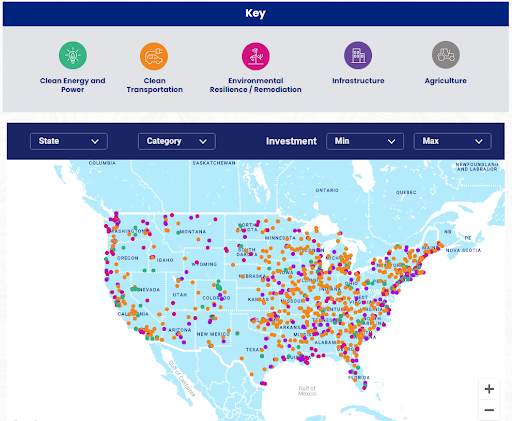
by Francisco Sayu | Apr 26, 2023 | Electric Vehicles, Electrification, Inflation Reduction Act
The clean energy revolution is taking place across America, and Wisconsin communities can benefit in several ways. For example, by transitioning from fossil fuels to renewable energy, the state can reduce its dependence on expensive fuel imports, which currently amount to $14 billion annually. Clean energy can also support new jobs, attract private investment, reduce carbon emissions, improve public health, and create a more sustainable environment for future generations.
The federal government has ambitious clean energy goals, and communities across Wisconsin are taking advantage of federal programs like the Infrastructure Investment and Jobs Act (IIJA) and the Inflation Reduction Act (IRA) to replace aging diesel school buses, rebuild bridges and ports, and improve air quality and resiliency. This blog post highlights clean energy investments made in Wisconsin communities through the IIJA and the IRA (see table below). Projects were identified using “The Climate Wins Here map” developed by ActOnClimate. Feel free to use this interactive tool to learn about ongoing clean energy investments in Wisconsin and beyond.
Despite these wins, we must do more to support clean energy deployments in the state. A recent Wisconsin Public Radio report highlights that rural communities are disadvantaged when competing for federal funding. Paradoxically, these rural communities have the greatest needs and opportunities to benefit from federal funding. Whether it is a solar project that reduces coal imports, a new electric school bus that cuts fuel costs, or a microgrid that increases reliability, these projects improve the quality of life for host communities.
In her book “Rural Renaissance, Revitalizing America’s Hometowns through Clean Power” Michelle Moore presents a practical and inspiring guide to creating economic opportunity through clean energy. Moore uses examples from communities across the U.S. leveraging natural resources, cooperative work, and innovation to bring electricity and prosperity to rural America. Today, the clean energy transition provides another opportunity to leverage our abundant resources (sunlight, wind, and land) and federal clean energy investments to create a more prosperous life for all Wisconsinites. It is up to us, and we must seize this opportunity.
In short, federal clean energy legislation has opened up new opportunities for communities in Wisconsin to improve their quality of life. The Climate Wins Here map is a helpful tool for identifying ongoing clean energy investments in the state. We encourage communities to use data, technology, and partnerships to build a cleaner, more sustainable future through clean energy. Feel free to contact RENEW for more information about federal funding for clean energy projects in your community.
Federal Clean Energy Investments in Wisconsin, April 2023
Project
|
Category
|
Agency
|
Funding Amount
|
ARP Enhanced Air Quality Monitoring Competitive Grant
|
Clean Energy and Power
|
EPA
|
$429,746
|
ARP Enhanced Air Quality Monitoring Competitive Grant
|
Clean Energy and Power
|
EPA
|
$500,000
|
Awarded Clean School Bus Program Rebates
|
Clean Transportation
|
EPA
|
$790,000
|
Awarded Clean School Bus Program Rebates
|
Clean Transportation
|
EPA
|
$3,950,000
|
Awarded Clean School Bus Program Rebates
|
Clean Transportation
|
EPA
|
$4,740,000
|
Awarded Clean School Bus Program Rebates
|
Clean Transportation
|
EPA
|
$ 1,975,000
|
Awarded Clean School Bus Program Rebates
|
Clean Transportation
|
EPA
|
$1,185,000
|
Awarded Clean School Bus Program Rebates
|
Clean Transportation
|
EPA
|
$1,885,000
|
Awarded Clean School Bus Program Rebates
|
Clean Transportation
|
EPA
|
$395,000
|
Awarded Clean School Bus Program Rebates
|
Clean Transportation
|
EPA
|
$30,000
|
Awarded Clean School Bus Program Rebates
|
Clean Transportation
|
EPA
|
$790,000
|
Awarded Clean School Bus Program Rebates
|
Clean Transportation
|
EPA
|
$1,580,000
|
Awarded Clean School Bus Program Rebates
|
Clean Transportation
|
EPA
|
$395,000
|
Awarded Clean School Bus Program Rebates
|
Clean Transportation
|
EPA
|
$2,370,000
|
Awarded Clean School Bus Program Rebates
|
Clean Transportation
|
EPA
|
$150,000
|
FTA Bus and Low- and No- Emission Grant Awards
|
Clean Transportation
|
DOT
|
$3,796,872
|
Awarded Clean School Bus Program Rebates
|
Clean Transportation
|
EPA
|
$395,000
|
Promoting Resilient Operations for Transformative, Efficient, and Cost-Saving Transportation
|
Environmental Resilience/Remediation
|
DOT
|
$201,221
|
Tribal Climate Resilience
|
Environmental Resilience/Remediation
|
DOI
|
$250,000
|
Tribal Climate Resilience
|
Environmental Resilience/Remediation
|
DOI
|
$212,079
|
National Coastal Resilience Fund
|
Environmental Resilience/Remediation
|
NOAA
|
$455,800
|
RAISE 2022 Grant Award
|
Infrastructure
|
DOT
|
$2,952,050
|
Port Infrastructure Development Grant Awards
|
Infrastructure
|
DOT
|
$10,134,800
|
RAISE 2022 Grant Award
|
Infrastructure
|
DOT
|
$5,341,931
|
RAISE 2022 Grant Award
|
Infrastructure
|
DOT
|
$13,476,269
|
|
|
Total
|
$58,380,768
|
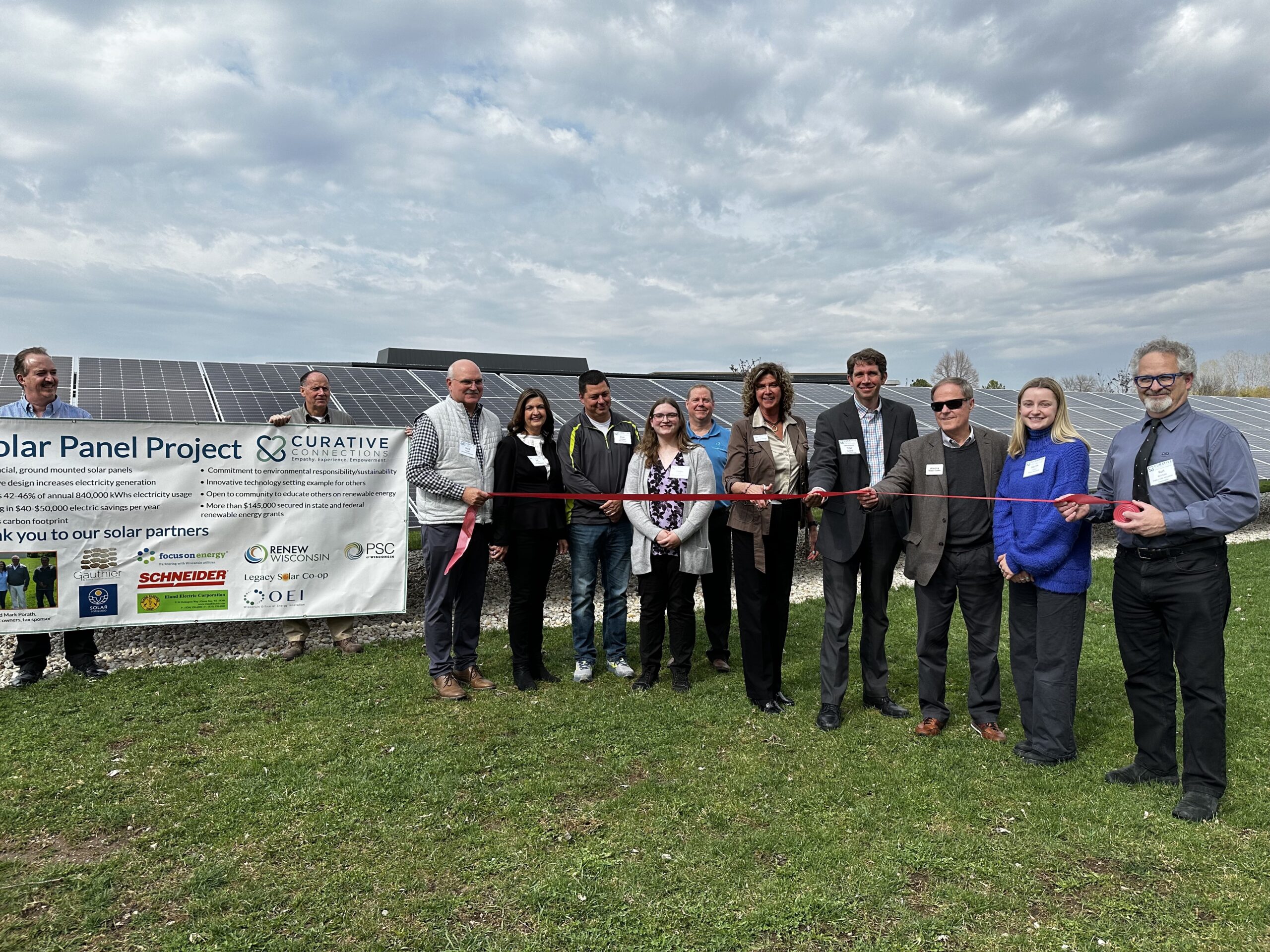
by Lauren Cohen | Apr 24, 2023 | Press Release, Solar, Solar for Good
On Thursday, April 20, Curative Connections held a ceremony dedicated to their new 280-kilowatt solar array. Curative Connections aims to help people reach their goals for independence by providing essential services to older adults and those with disabilities.
This solar system was installed by Eland Electric and is projected to offset 42-46% of the organization’s electricity usage. “We had a great experience with this project, from design and engineering all the way to commissioning,” said Jesse Michalski, Project Manager at Eland Electric. “This project was a little unique in that we had limited space and were trying to maximize the energy output of a solar array, and through the use of bi-facial modules, we were able to achieve a design that fits the customer’s goals.”
The economic implications of this array for Curative Connections are wide-reaching. The newly installed solar array is projected to bring the organization $50,000 of annual savings. “As a nonprofit, this is critical as we can now redirect these savings to support for our programs and the thousands of members
we serve each year,” said Jeanne Stangel, President and CEO of Curative Connections.
This solar installation is momentous as the organization celebrates an impressive milestone. “Curative Connections is proud to cut the ribbon on our solar project as it shines light upon another reason to celebrate our 75th anniversary year,” continued Stangel.
The project was funded largely by a $125,000 Office of Energy Innovation grant and financial support from Focus on Energy. Curative Connections also received a $10,000 grant from Solar for Good, a RENEW Wisconsin program run in partnership with the Couillard Solar Foundation.
“This solar project is a testament to the power of partnership between mission-driven nonprofits and clean energy advocates,” said Lauren Cohen, Program Coordinator with RENEW Wisconsin. “Solar for Good’s success is a direct result of organizations like Curative Connections leading the way towards a more sustainable future for Wisconsin and beyond.”
In addition to their grant funding, Curative Connections worked with Legacy Solar Cooperative to partner with a tax sponsor to take advantage of tax credits, which were not yet available to nonprofit organizations at the time of installation.
“We are grateful for the support we received from foundations, federal and state grants, and community partners,” continued Stangel. “This is a collaborative effort of a commitment to environmental responsibility and sustainability.”
With 75 years of serving the public under their belt, the money saved from this solar installation will allow Curative Connections to continue its mission to ensure that everyone receives the care they deserve. This project demonstrates the organization’s commitment to this mission and the environment, which others can look to and hopefully be inspired to embark on a similar path.
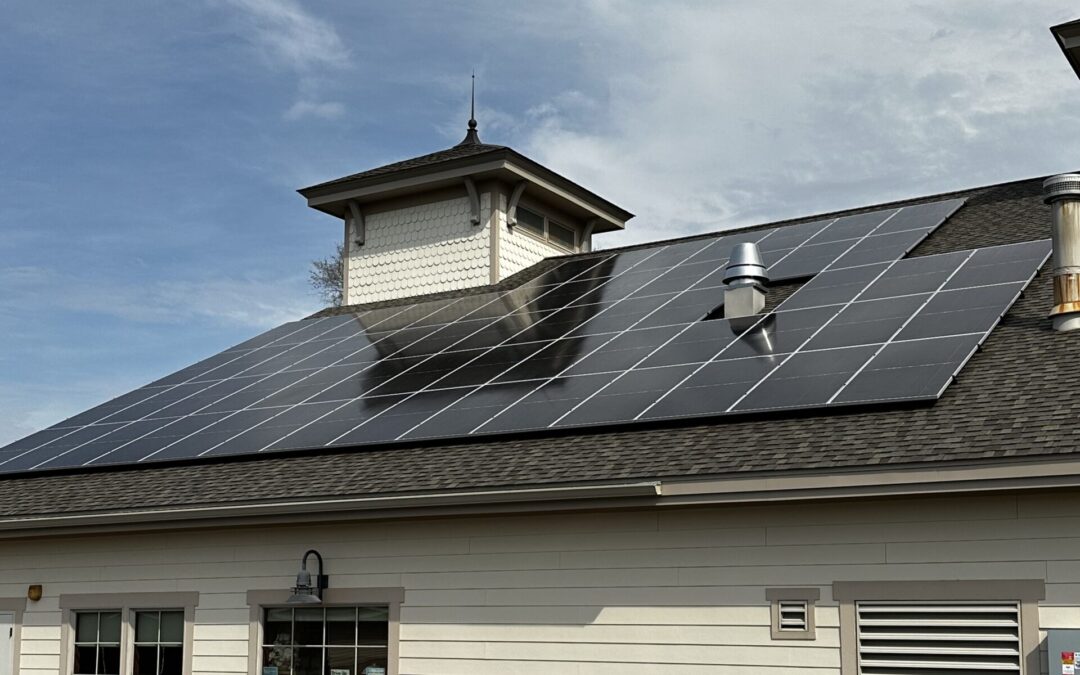
by Lauren Cohen | Apr 17, 2023 | Press Release, Solar, Solar for Good
On Saturday, April 15, the Shirley M. Wright Memorial Library held a solar dedication ceremony for their 32-kilowatt, newly constructed solar array. Scenically located on the Mississippi River and the bluffs of the Driftless Region, the Shirley M. Wright Memorial Library is dedicated to serving the rural communities of Trempealeau by offering free and equitable access to lifelong learning and enrichment.
The project, installed by Ethos Green Power, consists of 60 solar panels and is projected to offset 100% of the library’s electric needs. “This investment will save thousands in tax dollars that can be repurposed for other community needs,” said Alicia Leinberger of Ethos Green Power Cooperative. “In just a few years, the savings will offset the initial investment, providing decades of free electricity harvesting sunshine on the library roof.”
The library received over $83,000 in grants and incentives to install this solar array. Among these, the Shirley M. Wright Memorial Library received an EBSCO Solar Grant, a program that funds library solar installations.
The Shirley M. Wright Memorial Library was also awarded a panel grant from Solar for Good, an initiative provided by RENEW Wisconsin and the Couillard Solar Foundation to expand solar power within the state. The grant provided 30 of the 60 solar modules necessary for the project. “The solar grants and incentives we received will help the library purchase less power generated by fossil fuels, allowing our library to be financially and environmentally sustainable, all while acting as a catalyst to inspire change in the community,” said Jessica Schoonover, Library Director.
The library has laid out several opportunities for the community to interact with and be inspired by this solar array. “The very visible solar panels and the monitoring available on the website make it easy for the public to get curious,” continued Leinberger.
This solar installation will be an example to the Trempealeau community, showing its residents the economic and environmental benefits of adopting sustainable practices. It is just one aspect of a new initiative the library is adopting called SWML Renew, aimed at beginning sustainable, energy-conserving changes to its footprint. “We are working on doing our part to develop, model, educate, and encourage our community to live mindfully of our environment,” continued Schoonover. “We hope to encourage our neighbors to consider energy-efficient ways they can Renew their homes and businesses to make a more resilient future for Trempealeau.”
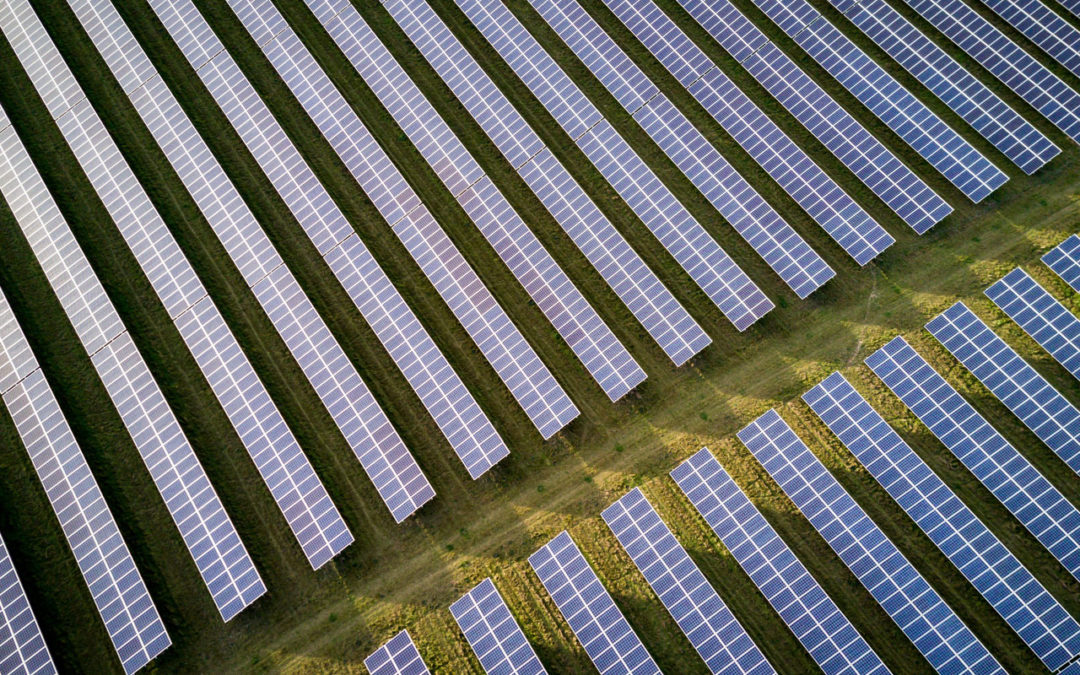
by Michael Vickerman | Apr 6, 2023 | Action Alert, Advocacy, Public Service Commission, Solar, Utility Scale
Langdon Mills Solar is a 200-megawatt solar project with a 50 MW battery energy storage system proposed for development in the Towns of Courtland and Springvale in Columbia County, Wisconsin. As designed, Langdon Mills Solar would generate homegrown, affordable, emission-free electricity sufficient to power the equivalent of approximately 30,000 homes. If approved, construction on Langdon Mills will begin in 2024 and is anticipated to be operational in 2026. For more information, visit the application here. If you want to learn more about how Langdon Mills Solar has engaged with the community, check out their website here. RENEW Wisconsin submitted testimony in support of Langdon Mills Solar in Docket 9818-CE-100, which you can access here.
Solar projects larger than 100 megawatts must gain approval from the Public Service Commission of Wisconsin (PSCW) before they can proceed to construction. Along the way, there are opportunities for public comment at the township, county, and state levels.
Please help us demonstrate Wisconsin’s enthusiastic support for solar power and this project by submitting a comment supporting Langdon Mills Solar. Be sure to specifically reference the project and the benefits that it can bring to Wisconsin. The deadline for submitting comments is May 23, 2023.
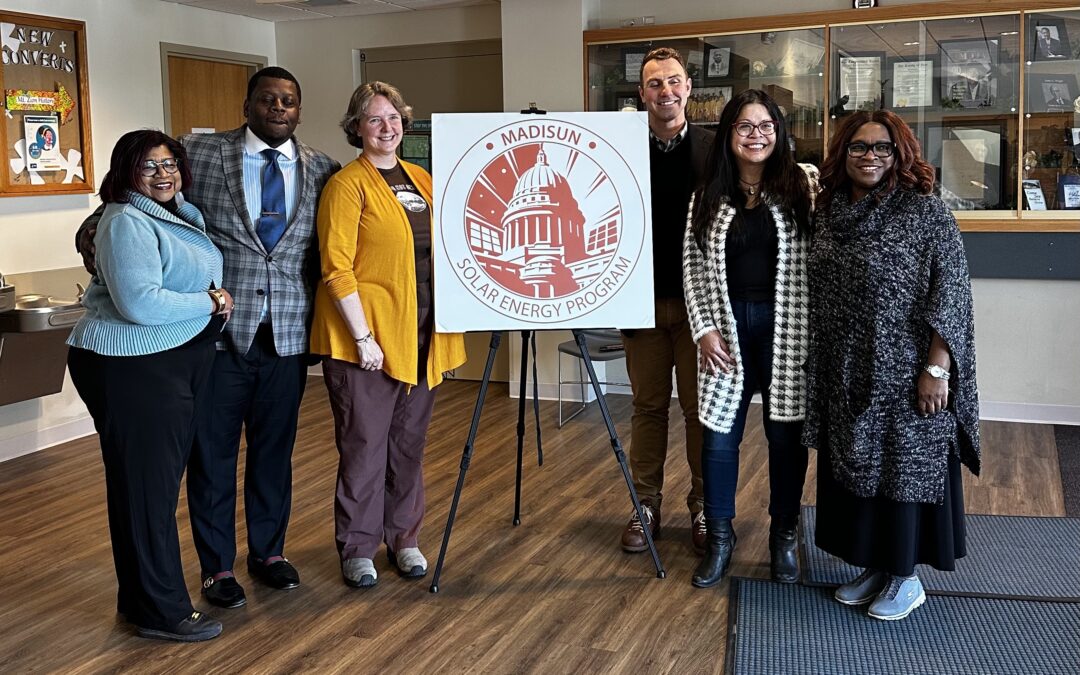
by Julia Holzschuh | Mar 29, 2023 | Press Release, Programs, RENEW Wisconsin
On Tuesday, Madison Mayor Satya Rhodes-Conway and RENEW Wisconsin announced the launch of MadiSUN’s 2023 Solar Programs, the City’s initiative to expand solar energy for local homes, businesses, affordable housing providers, and nonprofits. Participants included Sam Dunaiski, Executive Director of RENEW Wisconsin; Rev. Dr. Marcus Allen Sr., Pastor of Mt. Zion Baptist Church; and Maria Redmond, Director of the Wisconsin Office of Sustainability and Clean Energy.
MadiSUN is the City of Madison’s initiative to help foster the expansion of solar renewable energy. It consists of three programs: Group Buy for Homes, Solar for Businesses, and the Backyard Solar Grant. The Group Buy for Homes program simplifies the process of going solar for Dane County homeowners by putting them into direct contact with reputable solar installers. Since 2016, it has helped 289 Dane County residents install solar panels, totaling over 1600 kW. Solar for Business aims to educate and encourage Madison-based businesses to install solar power at their facilities. Since the program’s inception in 2018, they have awarded grants to 24 businesses with an aggregate capacity of 1600-kW and a total investment of $2,200,435. The Backyard Solar Grant fosters access to solar power for Madison-based community organizations and affordable housing providers that serve City of Madison residents. 19 organizations have received grants from the Backyard Program, with Mt. Zion Baptist Church receiving a $10,000 grant in 2021 for their 21.6-kW solar array. Looking forward to the 2023 season, MadiSUN is optimistic about the new possibilities presented by the Inflation Reduction Act on the programs. With nonprofit organizations now able to utilize previously unavailable solar incentives and an increase in the Solar Investment Tax Credit, RENEW is excited to facilitate the continued growth of these programs.
“I anticipate 2023 will be our best year yet!” said Sam Dunaiski, Executive Director of RENEW Wisconsin, “As administrator of the MadiSUN programs, RENEW believes in an all-of-the-above approach to renewable energy adoption. MadiSUN helps community organizations lower the upfront costs of solar, it helps Madison businesses navigate the questions around commercial solar implementation, and it makes going solar easy and affordable for local homeowners. These solar projects will help residents throughout the Madison area save money on their utility bills and reduce their carbon footprint.”
“We felt that installing a solar system would help the church serve the South Madison community by providing an example of leadership in demonstrating to the minority community the importance of good environmental stewardship.” said Pastor Allen of Mt. Zion Baptist Church. “We want to show the community the potential of long-term benefits of reducing dependence on nonrenewable resources thus, reducing the church’s carbon footprint.”
Federal investments from the Inflation Reduction Act (IRA) will complement and accelerate Madison’s Climate Forward Agenda by providing much-needed funding to reduce greenhouse gas emissions from the building and transportation sectors. IRA incentives will help increase the reach of City programs that support energy efficiency upgrades to naturally occurring affordable housing, and rooftop solar for homes and businesses through MadiSUN, and accelerate the transition of the City’s fleet to low- and no-carbon fuels, among other ongoing initiatives. The timing is fortuitous for new programs as well. The City’s new Building Energy Savings Program will help large commercial building owners identify opportunities to increase their energy efficiency and save money.
“I am very excited about the opportunities President Biden’s Inflation Reduction Act will bring for our MadiSUN program. The bill will allow thousands of Madisonians to transition to clean energy and grow the energy efficiency of their homes and businesses,” said Mayor Satya Rhodes-Conway.
The IRA will help Madison accelerate and reach its climate goals by providing funding directly to local households, businesses, and nonprofits to reduce energy costs and make clean energy and transportation more accessible for everyone. This can be done through: home energy efficiency upgrades, home energy systems, using electric vehicles, growing Wisconsin’s green economy, and by businesses utilizing energy cost savings.
- Home energy efficiency upgrades – The law includes rebates for energy-efficient electric heat pumps, water heaters, stoves, ovens, or other home appliances with more energy-efficient electric appliances for low- and moderate-income households. Any household can receive tax credits covering 30% of the cost of home construction projects on windows, doors, insulation, or other weatherization measures that reduce energy waste. These upgrades can lower home energy bills by at least $350 annually.
- Home energy systems – Households can also receive tax credits to cover 30% of installation of solar panels or battery storage costs. The average family installing solar using this credit would save $9,000 on their electricity bill over the system’s life, or about $300 per year.
- Electric vehicles – The IRA makes electric vehicles more affordable by providing up-front discounts of up to $7,500 for new and $4,000 for used electric vehicles, helping families save as much as $950 per year on fuel costs. Businesses can receive tax credits of up to $40,000 for commercial electric vehicles and a $100,000 tax credit for installing EV charging infrastructure in qualified census tracts.
- Growing Wisconsin’s green economy – Between 2023 and 2030, the IRA will bring an estimated $4 billion of investment to boost our manufacturing industry, employing an average of 472,000 workers.
- Business energy cost savings – Through the IRA, small businesses can receive a tax credit that covers 30% of the cost of switching over to low-cost solar power.
More information about the MadiSUN programs can be found on the programs website or by contacting the program coordinator Lauren Cohen at RENEW Wisconsin.
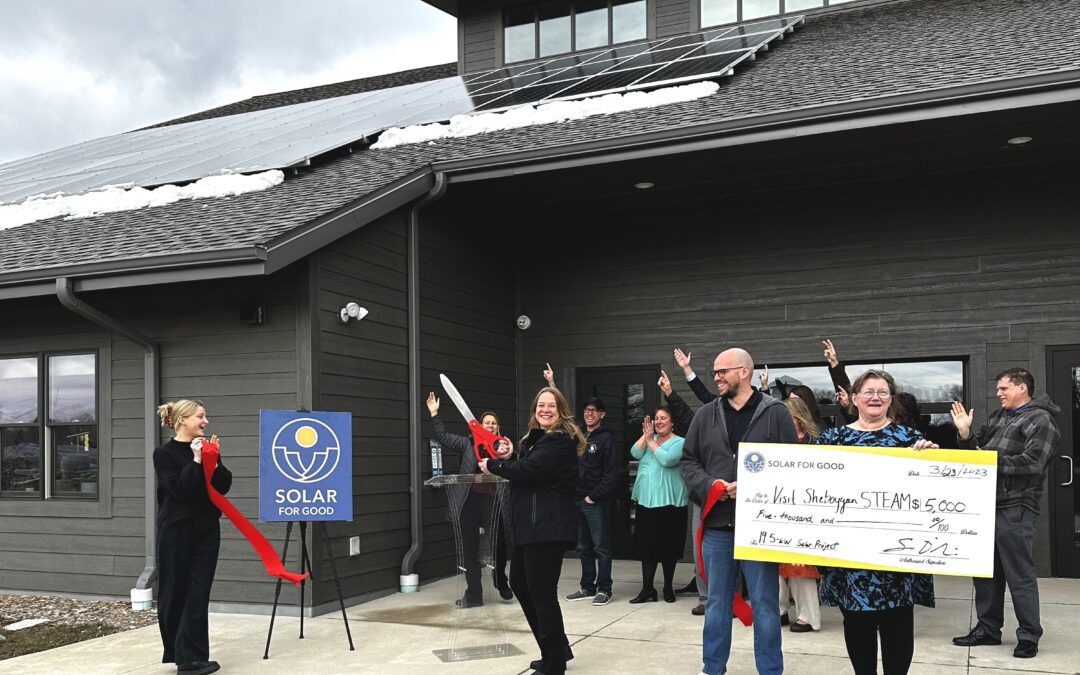
by Lauren Cohen | Mar 24, 2023 | Solar, Solar for Good
On Thursday, March 23, Visit Sheboygan STEAM held a ribbon-cutting ceremony for their 19.5-kilowatt solar array. Visit Sheboygan STEAM is a nonprofit organization that provides innovative science, technology, and urban ecology education.
The project, installed by Arch Solar, consists of 52 solar panels and is projected to offset approximately 28% of the building’s electrical needs and 56% of Visit Sheboygan STEAM’s production. “We had a blast working with Visit Sheboygan STEAM on their solar installation,” said Andrew Holmstrom at Arch Solar. “Installing on such a river-visible location, in downtown Sheboygan, meant a lot of Arch.”
Visit Sheboygan STEAM’s provides environmental and urban ecology education, and those involved with the STEAM program are excited by the solar installation’s educational opportunities. “The mission of our organization includes environmentally focused STEAM education, and this project will help us facilitate a new line of programming featuring photovoltaics and renewable energy,” said Kathy Cannistra, Program Developer at Visit Sheboygan STEAM.
As a popular destination among locals and tourists, Visit Sheboygan STEAM’s solar installation is a role model for similar organizations to follow in their footsteps. “All of Sheboygan County is in the early adoption stages of solar, so influential organizations paving the way are crucial in its development,” continued Holmstrom. “As time goes on, and the STEAM program grows, we’re looking forward to getting involved and providing education to the leaders of tomorrow on clean energy.”
This project was primarily funded by the organization’s existing donor base and business sponsors. In addition, RENEW Wisconsin’s Solar for Good program provided Visit Sheboygan STEAM with a $5,000 grant to assist with the upfront cost of the solar array.
“Environmental stewardship and education are core to our mission,” continued Cannistra. “Therefore, we are thrilled that this solar project has helped reduce the energy-related costs of our STEAM (Science, Technology, Engineering, Art, Math) programming while simultaneously demonstrating that solar power can be effective in our climate and region.”

by Lauren Cohen | Mar 24, 2023 | Events, Programs, Solar
On February 7, 2023, and March 2, 2023, RENEW Wisconsin and
Midwest Renewable Energy Association (MREA) hosted two Solar Workforce Training Courses at Madison Technical College as part of the MadiSUN Solar Energy Program.
MadiSUN is the City of Madison’s solar program administered by RENEW Wisconsin.
Solar installer is one of the fastest-growing jobs in the United States. Madison has a robust solar market, and solar installers struggle to find enough qualified employees. In response to this need, RENEW Wisconsin crafted a solar workforce initiative that had two primary goals:
1. To increase the number of qualified, trained workers in our community that local solar contractors could utilize to expand the total solar capacity installed in Madison.
2. To increase family-supporting careers within communities of color and low-income communities in the City of Madison.
To fulfill these goals, RENEW Wisconsin partnered with MREA instructors to host two “Solar 100” training sessions. These classes were each a one-day (8-hour) course that introduced participants to solar photovoltaic (PV) technology and workplace safety.
The course catered to those interested in a career in solar but unsure where to begin. It provided participants with many basic skills necessary for a career in the solar industry, making them more appealing to solar installation companies.
In the future, RENEW is working to find additional opportunities for participants of the Solar 100 class to take advanced training to obtain full North American Board of Certified Energy Practitioners (NABCEP) certification. While NABCEP certification is not needed to become a solar energy professional, it gives individuals more opportunities to further their careers.
Thank you to the City of Madison, MREA, and the students who made this initiative a success. We hope to provide more training opportunities in the future to advance clean energy in Wisconsin.

by Michael Vickerman | Mar 23, 2023 | Action Alert, Advocacy, Public Service Commission, Solar, Utility Scale
Elk Creek Solar is a 300-megawatt solar project with a 76.6 MW battery energy storage system proposed in the Township of Springbrook in Dunn County, Wisconsin. As designed, Elk Creek Solar would supply homegrown, affordable, emission-free electricity to power the equivalent of approximately 60,000 homes. If approved, Elk Creek will begin producing clean power by the end of 2025. For more information, visit the application HERE. If you would like to learn more about how Elk Creek Solar is engaging with the community, check out their website HERE. If approved, Elk Creek will begin producing clean power by the end of 2025. RENEW Wisconsin submitted testimony in support of Elk Creek Solar, which you can access HERE.
Solar projects larger than 100 megawatts must gain approval from the Public Service Commission of Wisconsin (PSCW) before they can proceed to construction. Along the way, there are opportunities for public comment at the township, county, and state levels.
Please help us demonstrate Wisconsin’s enthusiastic support for solar power in general and this project in particular by submitting a comment in support of Elk Creek Solar. Be sure to specifically reference the project and the benefits that it can bring to Wisconsin. The deadline for submitting comments is May 12, 2023.









